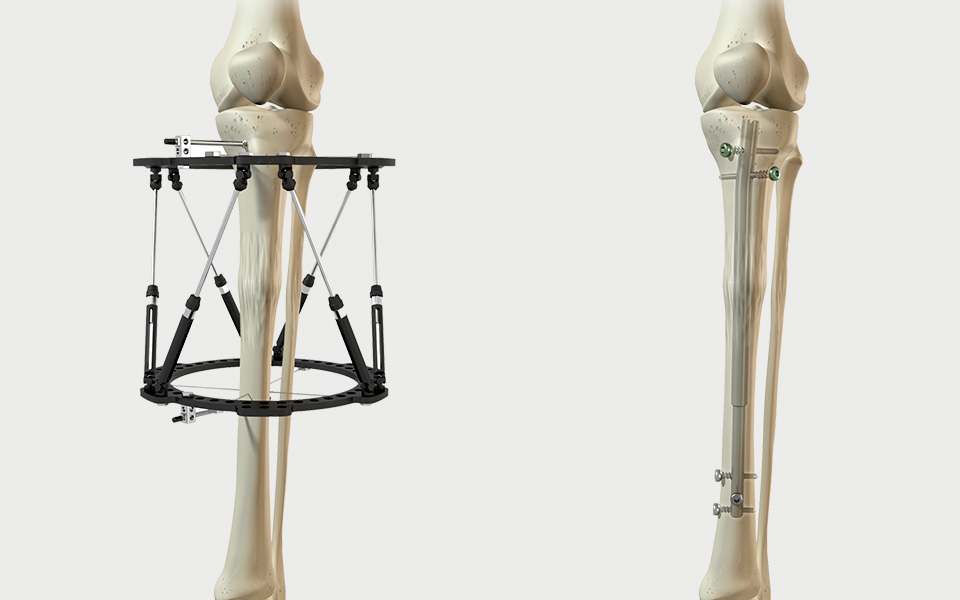A Two-Step Approach to Limb Lengthening
What Is Lengthening and Then Nailing?
Lengthening and Then Nailing (LATN) is a limb lengthening technique that separates the bone distraction phase from the internal stabilisation phase. This method involves using an external fixator to lengthen the bone gradually before replacing it with an intramedullary nail for long-term stability. By reducing the time spent with an external device, LATN provides a more comfortable and structured approach to bone lengthening while lowering the risk of complications.
LATN is commonly used for patients who require significant limb lengthening while maintaining bone alignment and function throughout the process.
Who Can Benefit from Lengthening and Then Nailing?
LATN is suitable for individuals who:
- Have congenital limb length discrepancies or acquired deformities.
- Require substantial limb lengthening without prolonged external fixation.
- Need a staged approach to ensure proper bone growth and healing.
- Have previous injuries or surgeries that resulted in limb shortening.
Common Concerns About Lengthening and Then Nailing
Is LATN Safe?
Yes. LATN is a widely used technique in limb lengthening that offers a controlled and predictable approach to bone distraction. By transitioning from an external fixator to an intramedullary nail, this method reduces infection risks and provides long-term stability.
How Long Does Recovery Take?
The recovery process includes:
- Lengthening Phase – The external fixator is used to lengthen the bone at a rate of approximately 1 mm per day. This phase typically lasts 2-3 months.
- Transition to Nailing – Once the target length is achieved, the external fixator is removed, and an intramedullary nail is inserted for internal stability.
- Bone Consolidation – The newly formed bone continues to harden over several months, with full recovery taking 9-12 months.
Will There Be Pain?
Mild to moderate discomfort is common, particularly during the lengthening phase. However, effective pain management, including medications and physiotherapy, helps patients manage discomfort and maintain mobility.
What Are the Risks?
As with any surgical procedure, LATN carries some risks, such as bone healing delays, stiffness, and pin site infections during the external fixation phase. However, with regular monitoring and post-surgical rehabilitation, these risks are minimised.
How Does Lengthening and Then Nailing Work?
- Surgical Preparation – The affected bone is surgically cut (osteotomy) under controlled conditions.
- External Fixator Application – A temporary external fixator is applied to initiate the lengthening process.
- Bone Distraction – The bone is gradually lengthened at a controlled rate using the external fixator.
- Intramedullary Nail Insertion – Once the desired length is reached, the external fixator is removed, and an internal nail is inserted to stabilise the bone.
- Final Recovery & Rehabilitation – The patient undergoes physiotherapy and follow-up monitoring to ensure proper healing and mobility.
Why Choose Advanced Orthopaedics for Lengthening and Then Nailing?
Skilled Surgical Team
Under the care of Dr Sarbjit Singh, a Senior Consultant Orthopaedic Surgeon, our clinic provides a structured approach to LATN, ensuring patient safety and effective treatment planning.
Reduced External Fixation Time
By transitioning to an internal nail after lengthening, patients spend less time with an external fixator, improving overall comfort and reducing the risk of complications.
Comprehensive Post-Surgical Support
Our clinic offers ongoing patient care, including physiotherapy, follow-up assessments, and personalised recovery plans to optimise healing and mobility.
Take the Next Step
If you are considering Lengthening and Then Nailing for limb correction, our team at Advanced Orthopaedics is here to help. Schedule a consultation today to explore your options and take the first step towards improved mobility and limb function.





